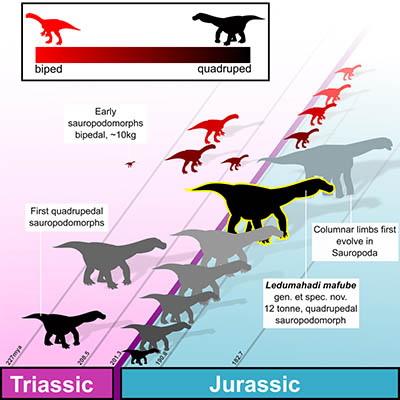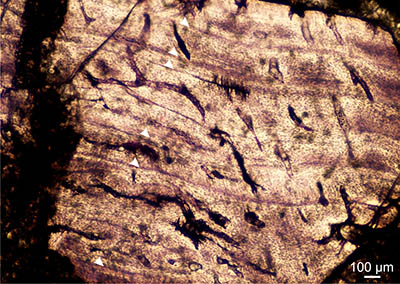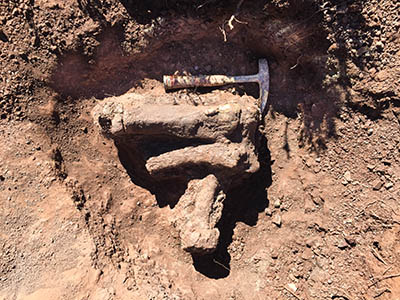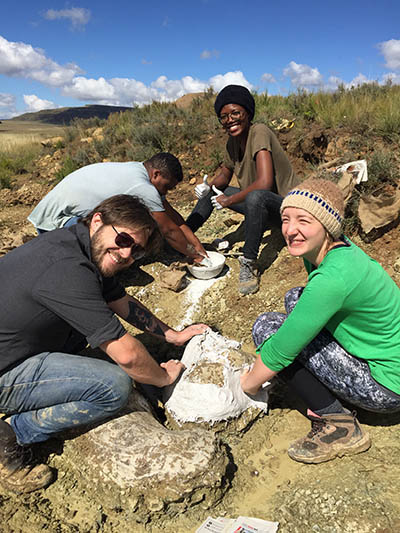A new species of a giant dinosaur has been found in the Free State province.
The plant-eating dinosaur, named Ledumahadi Mafube – Sesotho for “a giant thunderclap at dawn” – weighed 12 tonnes and stood about four metres high at the hips.

Ledumahadi mafube is the first of the true giant sauropods of the Jurassic. Quadrupedal postures with flexed limbs potentially evolved several times in sauropodomorph dinosaurs before the evolution of derived, columnar-limbed postures of Sauropoda.
Credit: Wits University

Closely spaced growth rings at the periphery is showing that the animal is an adult and that only a little bone tissue was deposited between the annually deposited growth rings, showing decreased growth rate.
Credit: Wits University

The partial foot of a large sauropodomorph dinosaur found by Kathleen Dollman and collected near Dordrecht, Eastern Cape during a field trip earlier this year.
Credit: Dr Pia Viglietti

Dr. James Neenan (Oxford Natural History Museum), ESI technician Gilbert Mokgethoa, and ESI MSc students Cebisa Mdekazi and Kathleen Dollman plaster the limb of a large sauropodomorph dinosaur from late Triassic deposits near Dordrecht, Eastern Cape.
Credit: Dr Pia Viglietti
An international team of scientists from the University of Cape Town (UCT), University of the Witwatersrand, Oxford University, and the South African National Museum have discovered that this plant eating dinosaur was the largest land animal alive on earth when it lived, nearly 200-million years ago. It was roughly double the size of a
large African elephant.
UCT palaeoscientist Dr Emese Bordy describes the discovery in the journal Current Biology: “We can tell from the properties of the sedimentary rock layers in which the bone fossils are preserved that 200-million years ago most of South Africa looked a lot more like the current region around Musina in the Limpopo Province of South Africa, or South Africa’s central Karoo.”
Ledumahadi lived in the area around Clarens, in the Free State. This is currently a scenic mountainous area, but looked much different at that time, with a flat, semi-arid landscape and shallow, intermittently dry, streambeds.
Ledumahadi is closely related to other gigantic dinosaurs from Argentina that lived at a similar time, which reinforces that the supercontinent of Pangaea was still assembled in the Early Jurassic. “It shows how easily dinosaurs could have walked from Johannesburg to Buenos Aires at that time,” says Wits University palaeontologist, Professor Johan Choiniere.
Ledumahadi is one of the closest relatives of sauropod dinosaurs. Sauropods, weighing up to 60 tonnes, include well-known species like Brontosaurus. All sauropods ate plants and stood on four legs, with a posture like modern elephants. Ledumahadi evolved its giant size independently from sauropods and, although it stood on four legs, its forelimbs would have been more crouched.
Because of this, the scientific team considers Ledumahadi was an evolutionary “experiment” with giant body size.
Ledumahadi’s fossil tells a fascinating story not only of its individual life history, but also the geographic history of where it lived, and of the evolutionary history of sauropod dinosaurs.
“The first thing that struck me about this animal is the incredible robustness of the limb bones,” comments lead author, Dr Blair McPhee. “It was of similar size to the gigantic sauropod dinosaurs but, whereas the arms and legs of those animals are typically quite slender, Ledumahadi’s are incredibly thick.
“To me this indicated that the path towards gigantism in sauropodomorphs was far from straightforward, and that the way that these animals solved the usual problems of life, such as eating and moving, was much more dynamic within the group than previously thought.”
The research team developed a new method, using measurements from the “arms” and “legs” to show that Ledumahadi walked on all fours, like the later sauropod dinosaurs, but unlike many other members of its own group alive at its time such as Massospondylus.
The team also showed that many earlier relatives of sauropods stood on all fours, that this body posture evolved more than once, and that it appeared earlier than scientists previously thought.
“Many giant dinosaurs walked on four legs but had ancestors that walked on two legs. Scientists want to know about this evolutionary change but, amazingly, no-one came up with a simple method to tell how each dinosaur walked, until now,” adds Professor Roger Benson.
By analysing the fossil’s bone tissue through osteohistological analysis, Dr Jennifer Botha-Brink from the South African National Museum in Bloemfontein established the animal’s age.
“We can tell by looking at the fossilised bone microstructure that the animal grew rapidly to adulthood. Closely-spaced, annually deposited growth rings at the periphery show that the growth rate had decreased substantially by the time it died,” says Dr Botha-Brink. This indicates that the animal had reached adulthood.
“It was also interesting to see that the bone tissues display aspects of both basal sauropodomorphs and the more derived sauropods, showing that Ledumahadi represents a transitional stage between these two major groups of dinosaurs.”
“South Africa employs some of the world’s top palaeontologists and it was a privilege to be able to build a working group with them and leading researchers in the UK,” explains Professor Choiniere, who recently emigrated from the US to South Africa. “Dinosaurs didn’t observe international boundaries and it’s important that our research groups don’t either.”
Main picture: The Highland Giant: Artist Viktor Radermacher’s reconstuction of what Ledumahadi mafube may have looked like. Another South African dinosaur, Heterodontosaurus tucki, watches in the foreground.
Copyright Viktor Radermacher

